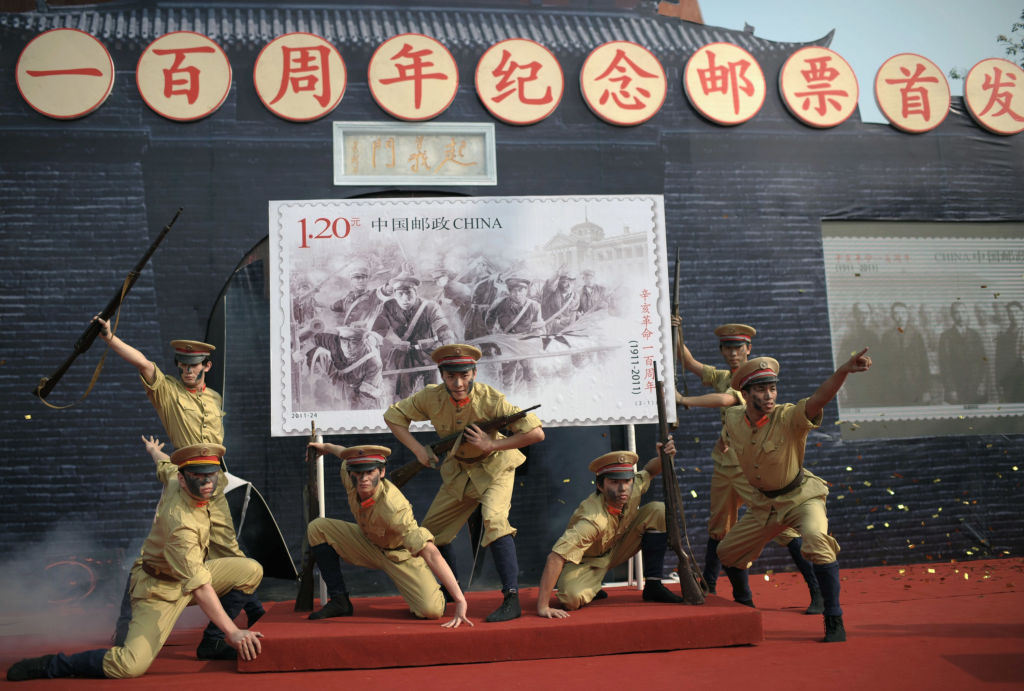
The 10th of October marked the anniversary of the Xinhai Revolution, the 1911 military insurrection in the city of Wuhan against the Qing imperial government. Coming after years of activism for reform and revolution, the insurrection spread throughout China and led to the end of the Qing dynasty and the founding of the Republic of China on 1 January 1912 by the Chinese Nationalist Party, or Kuomintang, under Sun Yat-sen.
The event is commemorated by Beijing as a critical historical event on the way to the founding of the People’s Republic of China in 1949, and by Taipei as the National Day of the Republic of China, also known as Double Ten. It is for both sides an event of immense contemporary political meaning. For Beijing, it is code for ‘reunification’ and what Xi Jinping calls the ‘Great rejuvenation of the Chinese nation’, while for Taipei, it expresses the deep contestation of Taiwan’s 20th-century history and the struggle for democracy.
As with every year, the day was marked by speeches, this year by Chinese Communist Party Chairman Xi and Taiwanese President Tsai Ing-wen.
On the PRC side, speaking on 9 October, Xi said, ‘The Revolution of 1911 will forever stand as a towering landmark on our nation’s journey toward rejuvenation.’ He outlined a deterministic historical narrative in which the end of the Qing and the history of the republic was one stage in China’s journey towards socialism led by the CCP: ‘With the salvoes of Russia’s October Revolution in 1917, Marxism–Leninism was brought to China, sparking a great awakening among the Chinese people.’ And, ‘Chinese communists were the most steadfast supporters, loyal collaborators, and faithful successors to the revolutionary cause initiated by Dr Sun Yat-sen.’
The teleological historical determinism in Xi’s speech is fundamental CCP ideology and a reminder that for Beijing and the party-state system, the unification of the mainland with Taiwan is a Marxist project. As Xi said, ‘History spirals upward, advancing in waves of progress.’ For the CCP, progress includes unification.
This ideological architecture includes historical materialism, which means culture and social identity are produced by economic conditions, or the ‘relations of production’, and hence economic integration between Taiwan and China should lead to a convergence of identities. Awkwardly for Marxist theory, it has stubbornly failed to do so. But the theory also includes the barriers to progress, those who stand against history’s tide, against whom the power of the state must be deployed, including its military power, and against whom the people must ‘struggle’ to achieve the goals of the revolution.
Xi continued: ‘Secession aimed at “Taiwan independence” is the greatest obstacle to national reunification and a grave danger to national rejuvenation. Those who forget their heritage, betray their motherland, and seek to split the country will come to no good end; they will be disdained by the people and condemned by history.’
In Taipei, 10 October is a commemoration of the National Day of the ROC, which has become the subject of political debate. By the time of the Xinhai Revolution in 1911, Taiwan had already been a Japanese colonial territory for 16 years, on a separate path to the formative historical events described by Xi. Taiwan was passed to the administration of the Republic of China in 1945 by the Allies following Japan’s defeat in World War II. In 1949, the ROC national government under Chiang Kai-shek and the Kuomintang retreated to Taiwan from the advancing communists and imposed the symbolism, and authoritarian practices, of the ROC state on the Taiwanese.
Since democratisation in the late 1980s, however, all of the ROC national symbolism and history on Taiwan has been open to intense public debate about its meaning and salience. Views range widely, sometimes acrimoniously, with some celebrating the republic and others rejecting it. Taiwan’s democratic system has adapted to this. The ROC national anthem especially is reinterpreted again and again to acknowledge its contested meaning, sometimes in very moving ways.
Tsai’s 10 October speech navigated these politics. She noted the history of the ROC after 1949, reached out to the new chairman of the opposition Kuomintang, Chu Li-luan, and leaned into campaign mode ahead of 2022 local elections in highlighting Taiwan’s success in managing the Covid-19 pandemic and sustaining economic growth.
She also emphasised democracy as Taiwan’s core national value and source of strength in its international relations: ‘[W]henever our nation’s dignity or the future of our people is at stake, we come together for the sake of the Taiwanese people to defend our sovereignty and our free and democratic way of life.’
The other major speech of the day was by the president of the Legislative Yuan, Taiwan’s parliament, Yu Shyi-kun. He directly addressed the history of Taiwan as distinct from that of the ROC and the PRC, and described a teleology of Taiwan’s own that led to democracy. Noting that 2021 was the centenary of the founding of the movement to establish a parliament in Taiwan, which petitioned the Imperial Diet in Tokyo for Taiwanese self-rule for more than a decade, he said, ‘Taiwan has spent a century pursuing democracy.’
Both Beijing and Taipei used the commemoration of the Xinhai Revolution to delineate their different ideological visions and the historical realisations and contemporary meanings of the event. For Taiwan, it is liberalism and democracy; for Beijing, it is Chinese Marxism and ‘socialism with Chinese characteristics’. This schism emerges from foundational ideological divides from the end of the 19th and the beginning of the 20th centuries.
Cross-strait relations are often understood in terms of democracy, authoritarianism, nationalism and state power in the international system. But they are at their core a contest of foundationally different visions for national progress and of the power of states to redraw or defend the boundaries of that contest with all the instruments available to them.

